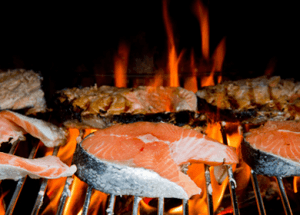
Barbequed, grilled, blackened and broiled fish may taste great, but beware! You may well be turning the healthy omega-3s found in fish into harmful compounds that can accelerate aging and the development of cardiovascular disease. Fear not though, the right cooking and meal creation techniques will deliver delicious foods that retain the healthful properties.
 Nearly 3 decades ago, low rates of cardiovascular disease, heart attack and stroke were found among Greenland Eskimos who subsisted on large amounts of fish. Similar results were also observed in other populations with high intakes of fish, such as Alaskan natives and and Japanese people residing in fishing villages.
Nearly 3 decades ago, low rates of cardiovascular disease, heart attack and stroke were found among Greenland Eskimos who subsisted on large amounts of fish. Similar results were also observed in other populations with high intakes of fish, such as Alaskan natives and and Japanese people residing in fishing villages.
These interesting results motivated many of us to increase the level of fish in our diets, particularly the high omega-3 fatty acid fish like salmon. Here is what is really interesting. Research reveals that it is not only what these people ate, but also how they prepared the fish. The fish was eaten raw, smoked, quickly seared, steamed and in soups. Direct flame, high temperature cooking, like broiling and grilling, was less used.
What is the impact of the cooking method? To start, high temperature cooking will cause much of the omega-3s to drip out of the fish. What is worse is that omega-3s that remain have been degraded and oxidized. Oxidized fats can make cholesterol more damaging. These oxidized compounds can damage the cell lining of the arteries. Together, the process that accelerates the aging of the arteries has been fueled.
How hot is too hot? You may have heard that you should not heat extra virgin olive oil beyond 325 degrees – that point at which the oil starts to smoke and undergo rapid oxidation. For sautéing and frying, fats and oils with higher smoke points are recommended. Omega-3s, however, are not a high temperature fat. In fact, omega-3s are among the least heat tolerant – rapid oxidation occurs at 225 degrees.
So, what is the ideal way to eat high omega-3 fish? “Cool” cooking techniques. Certainly, any water-based cooking technique like steam, poached or stewing works. Cooked in a liquid, the temperature will remain below the 225 degrees. Quick searing, like often used on a tuna steak, also preserve most of the omega-3s. And if you are looking for that barbequed flavor, try hot smoking on your outdoor grill.
Meal Planning Tip: When cooking any fish or meat on the barbeque, some level of oxidized compounds will be created. Deliver these great tasting foods with other recipes that deliver high levels of antioxidants from vegetables, herbs, spices and fruits. That’s right — antioxidants work to neutralize oxidized foods.
For more information on seafood and its health benefits, health risks and cooking techniques, see The Kardea Gourmet: Smart & Delicious Eating for a Healthy Heart.
– Rob Leighton
Author of many acclaimed books on nutrition, gourmet cooking, undieting and cardiovascular health, Rob is the creator of the Kardea Kitchen. The Kitchen is a resource for thousands of people seeking delicious, natural solution for heart healthy living and lasting weight loss. Learn more about Rob’s latest book, written with Dr. Richard Collins, The Cooking Cardiologist, and un-dieting expert, Susan Buckley, RD, CDE.

